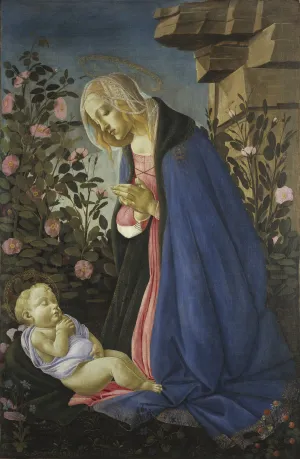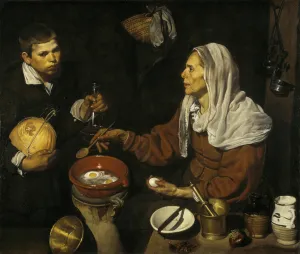Complete Checklist
Sandro Botticelli (Italian, 1444/45–1510)
The Virgin Adoring the Sleeping Christ Child, ca. 1485
Tempera, oil, and gold on canvas
48 x 31 3/4 in.
Scottish National Gallery, Edinburgh
© Trustees of the National Galleries of Scotland
A thornless rosebush and a rocky outcropping form a hortus conclusus, or enclosed garden — a symbol of the Virgin’s purity — where the young mother kneels in adoration before the slumbering Christ Child nestled on the hems of her gown and mantle. This masterpiece of Botticelli’s later years — known as the Wemyss Madonna for its longtime past owners, the Earls of Wemyss and March — is unusual among the artist’s religious works for being painted on canvas rather than wood panel.
El Greco (Domenikos Theotokopoulos)
(Greek, 1541–1614, active in Spain 1577–1614)
An Allegory (Fábula), ca. 1585–95
Oil on canvas
26 1/2 x 35 in.
Scottish National Gallery, Edinburgh
© Trustees of the National Galleries of Scotland
This enigmatic scene recalls Pliny the Elder’s description, from the first century c.e., of a painting depicting “a boy blowing a fire, which . . . throws a light upon the features of the youth.” In recreating, or rivaling, this lost work from antiquity, El Greco displays his virtuoso treatment of light and shadow. The embers and the boy’s face and fingertips glow against the surrounding darkness, and ridges of white paint sparkle along his collar, cuff, and nostril.
Diego Velázquez (Spanish, 1599–1660)
An Old Woman Cooking Eggs, 1618
Oil on canvas
39 1/2 x 47 in.
Scottish National Gallery, Edinburgh
© Trustees of the National Galleries of Scotland
In this work painted by Velázquez when he was only eighteen or nineteen years old and living in his native Seville, the figures and household objects stand out forcefully from the dark ground. The slightly disconnected gazes and suspended gestures of the old woman and the boy infuse tension into the scene. The artist showcases his remarkable technical skill through his differentiation of the textures of a wide variety of materials — from the wooden table and spoon and gleaming brass containers to the glazed earthenware and the eggs congealing in oil.
Jean-Antoine Watteau (French, 1684–1721)
Fêtes Vénitiennes, 1718–19
Oil on canvas
22 x 18 in.
Scottish National Gallery, Edinburgh
© Trustees of the National Galleries of Scotland
An especially sensual nude sculpture overlooks a gathering of elegant people in a parkland setting at dusk. To the tune of a musette (small bagpipe) played by the musician in shepherd’s dress at far right, a man in exotic costume and a woman in the elegant fashion of the day perform a stately dance. Rendered in fine brushstrokes and soft, sparkling tones, this celebrated work evidently had personal meaning for the artist.
Thomas Gainsborough (English, 1727–1788)
River Landscape with a View of a Distant Village, ca. 1748–50
Oil on canvas
30 x 59 1/2 in.
Scottish National Gallery, Edinburgh
© Trustees of the National Galleries of Scotland
This early work by Gainsborough presents a carefully composed scene stretched across a wide canvas, possibly intended to hang over a mantelpiece. Beneath an expanse of pale blue sky, a river winds through a valley toward a sunlit village. A path mirrors the river’s curves, and the rings of clouds echo the rise of the small hill at left. Gainsborough animates the scene with an encounter — possibly amorous — between traveler and milkmaid, along with a barking dog and other rustic figures and animals.
Allan Ramsay (Scottish, 1713–1784)
Margaret Lindsay of Evelick, Mrs. Allan Ramsay, ca. 1758–59
Oil on canvas
29 1/4 x 24 1/4 in.
Scottish National Gallery, Edinburgh
© Trustees of the National Galleries of Scotland
Ramsay produced this sensitive portrayal of his wife in London, most likely after the birth of their second surviving child. With painterly brushstrokes, he defines the lustrous pleats of her silk gown and the patterned lace of her sleeves and mantle. Margaret’s exquisite attire conveys her status as a daughter of a Scottish baronet and the spouse of a wealthy and successful artist. Pausing as though interrupted from her task of arranging flowers in a Chinese porcelain vase, she turns her gaze and delicate features toward the viewer.
Sir Joshua Reynolds (English, 1723–1792)
The Ladies Waldegrave, 1780–81
Oil on canvas
56 1/4 x 66 1/4 in.
Scottish National Gallery, Edinburgh
© Trustees of the National Galleries of Scotland
This large-scale informal group portrait, or conversation piece, depicts the Waldegrave sisters, the grandnieces of the author and antiquarian Horace Walpole, who commissioned the work for his celebrated country house, Strawberry Hill. Reynolds’s gift for creating sophisticated compositions and rendering graceful gestures — at its height here — helped to establish him as one of the foremost English portraitists of the eighteenth century.
Sir Henry Raeburn (Scottish, 1756–1823)
Colonel Alastair Ranaldson Macdonell, 15th Chief of Glengarry, 1812
Oil on canvas
95 1/4 x 59 1/2 in.
Scottish National Gallery, Edinburgh
© Trustees of the National Galleries of Scotland
This magisterial painting by Edinburgh’s foremost portraitist of the late eighteenth and early nineteenth centuries presents one of the most colorful characters of the era. Displayed to acclaim at the Royal Academy in London, the portrait secured Raeburn’s membership in the organization. An eccentric, larger-than-life figure, Alastair Ranaldson Macdonell of Glengarry, the fifteenth Chief of the Macdonell Clan, devoted his life to preserving and perpetuating the customs and traditions of the Highlands.
John Constable (English, 1776–1837)
The Vale of Dedham, 1827–28
Oil on canvas
57 x 48 in.
Scottish National Gallery, Edinburgh
© Trustees of the National Galleries of Scotland
A definitive treatment by Constable of his home territory and lifelong source of inspiration, this sweeping view of the Stour Valley combines compositional elements from a long-admired work by Claude Lorrain (Hagar and the Angel; National Gallery, London) with specific features of the area: the fertile farmland along the winding river, the Stratford toll bridge, the tower of the village church of Dedham, and the estuary at the horizon.
John Singer Sargent (American, 1856–1925)
Lady Agnew of Lochnaw, 1892
Oil on canvas
49 1/2 x 39 1/2 in.
Scottish National Gallery, Edinburgh
© Trustees of the National Galleries of Scotland
This portrait of the renowned society beauty Lady Agnew (née Gertrude Vernon) was commissioned by her husband, Sir Andrew Noel Agnew, a Scottish barrister. Through her direct, frontal gaze and the informality of her pose, the subject forges a compelling connection with the viewer. The colorful, patterned upholstery of the eighteenth-century French armchair and silk Chinese wall hanging harmonize with her elegant white gown trimmed in lilac. Sargent’s fluid brushwork conveys a sense of opulence and ease.










